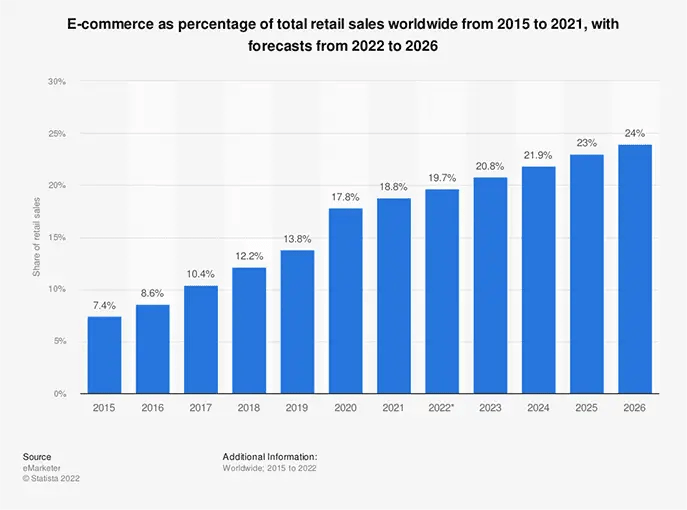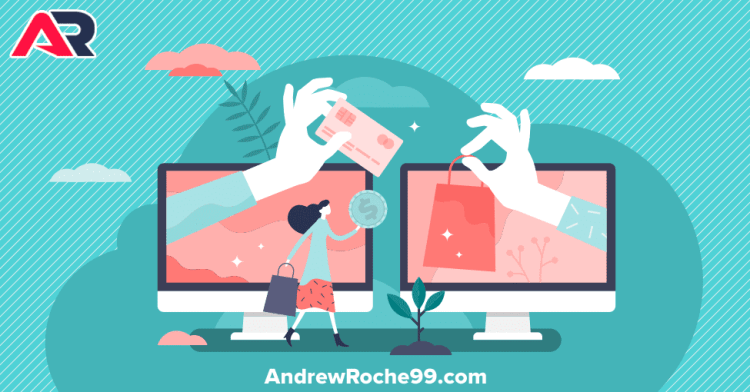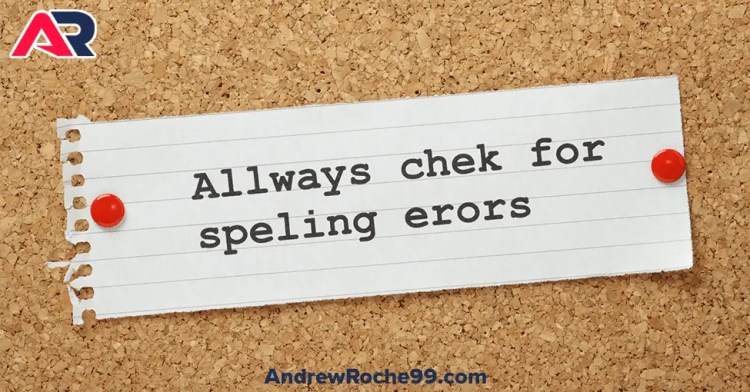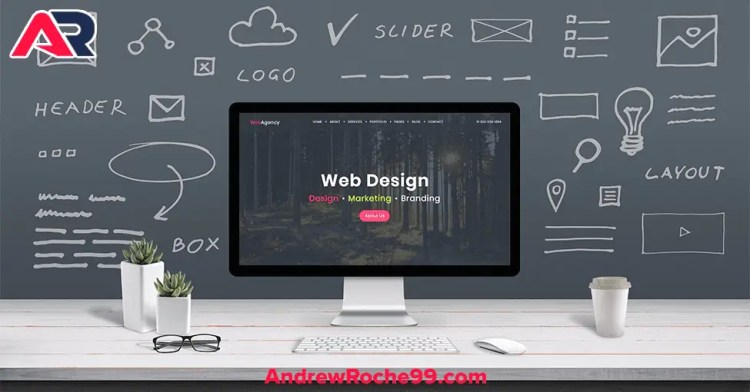The internet is woven throughout every aspect of our daily lives. We use it for socialization, entertainment, work, and research. We also use it to shop. There’s a generation of adults today who only know a world where the internet exists. As this generation, and the generations to follow, spend more money, eCommerce will continue to grow. Today, roughly 43% of shoppers use social media to research products before making a purchase. Furthermore, eCommerce revenue will surpass $1.3 trillion in the United States by 2025. That being said, your business needs to build an eCommerce website that dominates if you want to survive in the years to come.

Building an eCommerce website helps businesses reach new markets and provides an alternative income stream if they need to close their brick-and-mortar stores. If you are just getting your business off the ground, an eCommerce website can connect you with the global market and help you gain traction before you even open a physical store.
Creating a dedicated eCommerce website grants you the ability to control every element of your customer experience. You can opt to build it yourself or hire a developer. Either way, understanding the process will help you make intelligent decisions, so you can build a website that’s optimized to sell your products.
Ecommerce Selling Statistics
The eCommerce industry is growing every day and provides businesses with opportunities to connect and engage with their target audience. Therefore, a finely tuned eCommerce store will most definitely benefit from providing convenient shopping options to its consumers.
1.) eCommerce will make up 24% of global retail sales by 2026
Sales conducted via online stores are projected to reach 24% of global retail sales by 2026, versus 18.8% in 2021.

A portion of this growth is due to the increase in eCommerce sites. However, most of the growth is due to a shift in shopping trends. Businesses can make the most of this worldwide shift by providing customers with opportunities to purchase as soon as they decide and a product. Furthermore, businesses will have a far easier time reaching overseas consumers with international sites and shipping.
2.) eCommerce sales in Q1 of 2022 accounted for 14.3% of total sales
It’s estimated that 14.3% of sales in Q1 of 2022 were eCommerce sales. With the fallout of COVID-19, more people are shopping online and eCommerce sales have steadily increased. As more consumers shop online, business owners will have countless opportunities to prove that the best eCommerce sites provide excellent online services, which, in turn, builds loyalty in the post-COVID-19 world.
Why Build an eCommerce Website?
It’s obvious that the growth in eCommerce benefits the bottom line for many businesses. However, there are other reasons to create an eCommerce business. One such reason is that an online presence offers businesses ample opportunities to forge connections that lead to growth.
1.) Reach New Markets
For a lot of companies, especially small businesses, and startups, it’s hard to reach customers in new markets with just a storefront. With an eCommerce site, these fresh faces can reach new customers via the internet which would be impossible to reach with only a brick-and-mortar store.

2.) Develop a Unique Shopping Experience
Small businesses and startups can also directly impact the customer journey by creating a unique shopping experience. This unique shopping experience is made possible via videos, stories, and personalized services. These touchpoints don’t need to end at the checkout either. You can reach customers via email marketing or social media. These awesome experiences help convince customers that online shopping offers inclusive opportunities that a brick-and-mortar store simply cannot provide.
3.) Improve Your Brand
If you sell via an eCommerce site, such as eBay or Amazon, your products are listed generically and often use the marketplace’s branding. Some customers may not even realize that they’re purchasing from you and will not learn about your brand. You avoid this issue when you build your own eCommerce site. Building your own eCommerce site helps you control how you present your products, which helps your customers remember your brand, not the marketplace.
Step-by-step Guide to Building an eCommerce Website
Building an eCommerce website is actually pretty simple. There are now eCommerce solutions that do most of the work for you. However, you still need to understand what’s offer and what your site requires. If you do your research, you can build an awesome site that grows and evolves with you in the years to come.
Here’s a high-level overview of what you need to do:
- Select your perfect eCommerce platform.
- Purchase the right domain.
- Connect with a skilled developer.
- Pick your eCommerce theme.
- Customize your eCommerce template.
- Add your products.
- Set up payment options.
- Set up your shipping options.
- Preview, test, and publish your online store.

Select the Perfect Platform to Build Your eCommerce Website
Selecting the right eCommerce website builder is the first step in the process. It’s important that you select one that meets the needs of your products and brand.
1. Types of eCommerce Platforms
There are three types of eCommerce platforms, each of which suits different kinds of businesses and offer different functionalities. Here’s what you need to know:
Open Source
As the name suggests, open-source platforms provide their source code to anyone for free. It’s free to install and you can customize it to meet your needs. However, open-source platforms typically require advanced coding knowledge. Security breaches are also a concern, which means you need to hire a team dedicated to maintaining the security of your eCommerce site. This may end up costing you more than a subscription to another type of platform.
Saas
SaaS, or software as a service, are subscription service-based platforms. These systems are typically easy to use, scalable, and have intense security features. Since they’re designed specifically for eCommerce sites, they can handle the heavy logistical processes, such as checkout and payment processing.
Pricing is often a concern with SaaS since there’s a monthly subscription fee, transaction fees, and expenses for plug-in apps. Most services also have restricted branding, which limits your creativity when designing. Sites built on Wix, for example, have “powered by Wix” at the bottom of the screen. This means that you’re not only promoting your brand, but you’re also promoting the Wix brand. Premium services often give you more wiggle room to create a look and feel that emulates your brand and your brand only.
Headless Commerce
Headless commence keeps the display layer of an eCommerce site separate from the shopping cart. This means you can use a content management system (CMS), digital experience platform (DXP), progressive web app (PWA), or other technology on the front end and then use an eCommerce engine on the back end.
Headless commerce allows you to make customer-facing changes quickly and offers plenty of creative control. Furthermore, headless commerce allows companies to enter the market faster, at a lower cost, and increased control over their store while outsourcing security and PCI compliance.

2. eCommerce Hosting
eCommerce hosting is where you store your data. Where you host can impact your security and overall costs., so make sure you take the time when selecting your host.
Cloud
Cloud hosting is when sites are hosted off-site by a Saas or headless commerce company. The host manages the uptime as well as updates, patches, and upgrades that help keep the site secure. Open source options may also offer a cloud option that includes the cost of hosting, but typically require the merchant to maintain the security of their site.
On-Premise
On-premise hosting is when businesses host their site on servers that they own. The business needs to have space for the server, handle the installation, and hire people to look after it to make sure that the site stays up and secure. This option is typically the choice route for larger corporations.
3. Consider the Following When You Build an eCommerce Website
Multiple systems need to work in harmony so that you provide your customers with the best eCommerce experience possible. Let’s take a look at how your preferred eCommerce platform works in the following areas to ensure it performs at a high level both now and in the future.
Website Performance
Make sure the platform you select works and has a strong uptime track record. If the platform has a poor uptime record, your customers will not be able to purchase your products or services. Unlimited API calls make your website easier to manage and fast page load times provide customers with an overall awesome experience.

Traffic Capacity
Can your platform accommodate your current traffic needs? Does it have the ability to grow as your business expands? Does it handle major shopping days like Black Friday and Cyber Monday without crashing?
Mobile Optimization
More and more consumers are shopping on their mobile devices, so it’s critical that our website is optimized for an amazing mobile experience. You’ll want to look for ways to enhance customer experience via mobile technology such as geolocation, which helps customers locate the nearest store.
Secure Payments and Data
The platform you select must protect your data and your customer’s data. SaaS solutions typically include security features, such as SSL and PCI, as part of their monthly plans. Self-hosted and open-source solutions require a deeper understanding of security, as they’re more prone to malicious attacks.
4. eCommerce Website Builders
Your website builder is the framework of your online store. When you decide to use an eCommerce website builder, you get more options and the ability to grow that standard website builders with an eCommerce add-on simply don’t offer. Here are a few options to consider:
BigCommerce
This SaaS solution is known for scalability. It also offers 24/7 support, with priority support available to larger accounts. There are a ton of built-in features, multi-layered security, and an assortment of payment methods. BigCommerce supports headless, so you can deliver API-fueled experiences via CMS, DXP, application, device, or custom front-end.

Shopify
Shopify is another SaaS option that’s fully hosted and famous for its quick and easy set-up. This option offers a wide range of plugins. However, you need to be careful because you can rack up quite the bill if you add too many plugins. Shopify can handle a high frequency of transactions per minute, so it can easily manage traffic spikes.
Magento
Magento is a self-hosted option, so you have total creative control. However, you need someone who knows how to code to make the most of this platform. There’s a wide array of integrations, and it can handle instant purchases and product suggestions.
WooCommerce
WooCommerce is an open-source WordPress plugin, so it doesn’t cost a penny to install. It’s typically used by those with a pre-existing WordPress site. WooCommerce is flexible, offers unlimited customization, and industry experts audit the secure code.
Select Your Domain Name
If you already have a domain name, great! You can transfer it to your online store builder. If you don’t have a domain name, don’t worry! When you go to purchase your domain name, make sure to follow these best practices.

1. Avoid Creative Spellings
YOu want a domain name that’s easy to remember and type, so avoid creative spellings at all costs. Your domain name doesn’t need to pass a spelling test. I mean, google wasn’t a word until Google created it, but you want to make sure it’s easy to spell nonetheless. Make sure that it’s also easy to pronounce. You want customers to tell their friends about your eCommerce website, so avoid hyphens and numbers since these make it harder for people to easily share your web address.
2. Avoid Generic Names
There are two major problems with generic names. First, people forget the name, and second, they’ll go to a similar-sounding company that has a better SEO ranking. A strong name is memorable, so make sure that your domain name stands out.
3. Keep It Short and Sweet
Like a nice skirt, your domain should be long enough to cover the important stuff, but short enough to keep things interesting. That being said, you’ll want to keep your domain name between 6-14 characters in length. This makes it easier for customers to remember it. Shorter names are also more straightforward when it comes to marketing, which leads to more customers. This is true even if people are finding you through a search engine.
Find a Developer
Even if you’re operating on a shoestring budget, a developer can make the process of setting up your eCommerce site easier. They tend to have the technical knowledge to get you set up quickly, which means you can start selling sooner. When weighing your options, ask potential developers about their timeline, so you can plan your launch date. You’ll also want to ask to see other websites they’ve built and get references from those businesses. Lastly, you want to make sure that your developer shares your overall vision and can create what you’re looking for within your budget.

Select a Template that Matches Your Vision
Templates, or themes, are pages that are pre-built that you can customize to match your brand and help your site look amazing without a lick of design or coding skills. You should consider the following topics before you select a template.
1.) Customer Navigation
Smooth navigation is critical to an excellent customer experience. If a customer can’t find what they’re looking for, they’ll likely hit the back button and shop somewhere else. Your navigation bar should be easy to read and located on the left side of the page since customers (and most humans) read left to right.
2.) Style of the Homepage
You’ll definitely want to make sure that your template’s homepage properly represents your brand. Does it have areas for images, slideshows, and/or videos? Is there space for you to share your story with site visitors? A customer should be able to easily understand your business at first glance, so make sure your template clearly communicates this.
3.) Customization Options
Customization is a huge factor that you’ll want to consider. Is there a font and color scheme that matches your branding? How many images can you include? How will your products show up? Can you change how your customers will see your products? Can you embed your social media content? The majority of online store builders employ apps to add non-native features, so you’ll want to consider how many apps you need to make the template as close to perfect as possible.

Add Your Products
Your product pages are among the most important pages on your site. I mean, they show your customers what you have to sell. That being said, you need to take the time to display your products in the best way possible. You can do this by optimizing your product descriptions, including eye-catching images, and organizing your products into easy-to-navigate categories.
1.) Product Descriptions
Your product descriptions are among the most important elements of your eCommerce website. They describe the usefulness, colors, textures, measurements, and value of your products to your customers. Your product descriptions also allow bots to index your site for SEO purposes. You want to avoid cliches, long sentences, and complex phrasing when drafting your descriptions.
You also want to make sure that your descriptions answer the following questions:
- Who is the product for?
- What are the product’s basic details?
- Where would someone use the product?
- When would someone use the product?
2.) Product Images
Website visitors love images! This means that high-quality product images are a must. When producing product images, you need to consider the following:
Use High-Quality Images
Images convey the perceived quality and value of your products. High-quality photos help your products pop. Vibrant photos also make your products more appealing and encourage customers to continue clicking through your eCommerce website.
Make Sure Each Image is the Same Size
It’s critical that each image is the same size since different image sizes will likely misalign your gallery. You should use an image editor to adjust each picture to the required size.
Add Product Variation Images
Most images should be product-only images that showcase the product from all angles. You should also include an in-context photo that shows a person using the product. These are helpful on product pages and you can use them in social media content to boost emotional engagement.
3.) Product Categories
Nearly every eCommerce platform allows you to add your products to categories. Doing so helps your customers find what they’re looking for in your store. Categories are also helpful since they can coincide with filters to help visitors sort through brands, price ranges, or other characteristics. Furthermore, featured products are a great way to guide customers through the buyer’s journey.

Set Up Payment Methods
Offering the right payment methods is critical when it comes to closing a sale. If the method is overly complicated or not trustworthy, your customer will likely abandon their cart and never return to your store.
1.) Three Key Types of eCommerce Payment Gateways
There are three major types of payment gateways and each has its own pros and cons. When selecting a payment gateway, you need to think about what it takes to keep payments and user information secure.
Redirects
The redirect option takes customers to a separate site to process their payment. The most commonly used redirect is PayPal. This is probably the easiest solution for retailers. More importantly, it passes on the issue of security to PayPal. However, it does add another step for customers, which may turn some away.
Checkout On-Site, Payment Off-Site
This method hosts the front-end of the payment process, such as collecting details, and the payment is processed off-site. Stripe is a popular option that offers this service. It reduces the number of steps for customers, but you have to ensure that your site is properly encrypted so information is safely delivered to the payment processor.
On-Site Payments
This type of payment occurs on your site, which gives you total control and responsibility. It’s suitable for larger organizations that process a lot of payments and can afford to keep it both working and secure.

2.) Selecting Your Payment Integrations
A payment gateway integration is a secure method that secures and sends credit card data to your payment processor. It’s a critical part of your eCommerce website, so you need to do your research and understand the specifics.
Ease of Integration
Consider how easy it is to integrate the system into your site. Does it work with the eCommerce platform you selected?
Customer Reviews
Check out the customer reviews from other eCommerce websites. Is the gateway trustworthy? Does it work consistently? Have users had issues sending or receiving money?
Fees
There are fees involved in every step of the process – including taking payments and processing refunds. Make sure you read the fine print, so you know how much the system costs and that you are okay with the fees and overall price.
PCI Compliance & Security
PCI is short for the Payment Card Industry Data Security Standard. This ensures that credit card information is kept safe. Non-compliance often results in fines, lawsuits, and a loss of trust with your customers. That being said, you definitely need to make sure that your gateway is compliant and secure. You also want to secure your eCommerce website with an SSL certificate to ensure that all transactions and customer information are secure.

Figure Out Your Shipping Settings
Shipping is a vital component of any eCommerce website. Customer want products fast, so you need to select your shipping options wisely.
1.) Establish Your Shipping Policy
Your shipping policy outlines your fees and which carrier(s) you use. Are you offering free shipping, a flat rate, or a variable rate? Who are your shipping partners? You also want to consider if you plan to ship internationally. If you don’t plan to ship internationally, make it painfully clear so that international customers aren’t frustrated at checkout.
2.) Select Your eCommerce Shipping Solutions
Will you do the packing yourself, or are you dropshipping? Shipping software that works seamlessly with your workflow allows you to automate that portion of your business and frees you up to handle other matters.

Preview & Publish Your eCommerce Website
A successful launch depends on everything on your site working as planned. If a link doesn’t work, payments don’t process, or the site doesn’t look amazing on mobile devices, then you can expect a less-than-awesome conversion rate until you provide a seamless experience. That being said, you need to test everything before you hit the publish button.
1.) Does Your Checkout Work?
This is simple – run a sample order to make sure that everything works as planned. Can you add products to your cart? Does the payment go through? Do you receive all the necessary confirmation emails you were expecting?
2.) Do Your Store’s Functions Work?
This may seem tedious, but you need to test every button/link on your site. Do they work as planned? Do filters and categories work? If a link doesn’t work, does your 404 page direct customers back to your site?
3.) Does Your Store Work on Mobile?
Check out your eCommerce website on a mobile device. Are the dimensions correct? Are the buttons easy to click? Are your images crystal clear on a smaller screen?
4.) Test Your Site on Different Browsers
View your store on as many browsers as possible – a few of the major players include Chrome, Firefox, Safari, and Edge. Make sure your site works on all browsers. If you run into any issues, ask your developers to fix them ASAP.
5.) Set Up Your Store’s Settings
The store settings include things such as language, time zone, your address and contact info, tax, and measurement units. Check that these have all been set up correctly before you launch.
Closing Thoughts
A strong eCommerce website is more than just a place to sell your products. It’s where a business can develop an experience that improves its brand, attracts new customers, and converts casual customers into loyal ambassadors. Selecting the right eCommerce platform and developing a marketing strategy to create a successful online store can give you a huge headstart.






